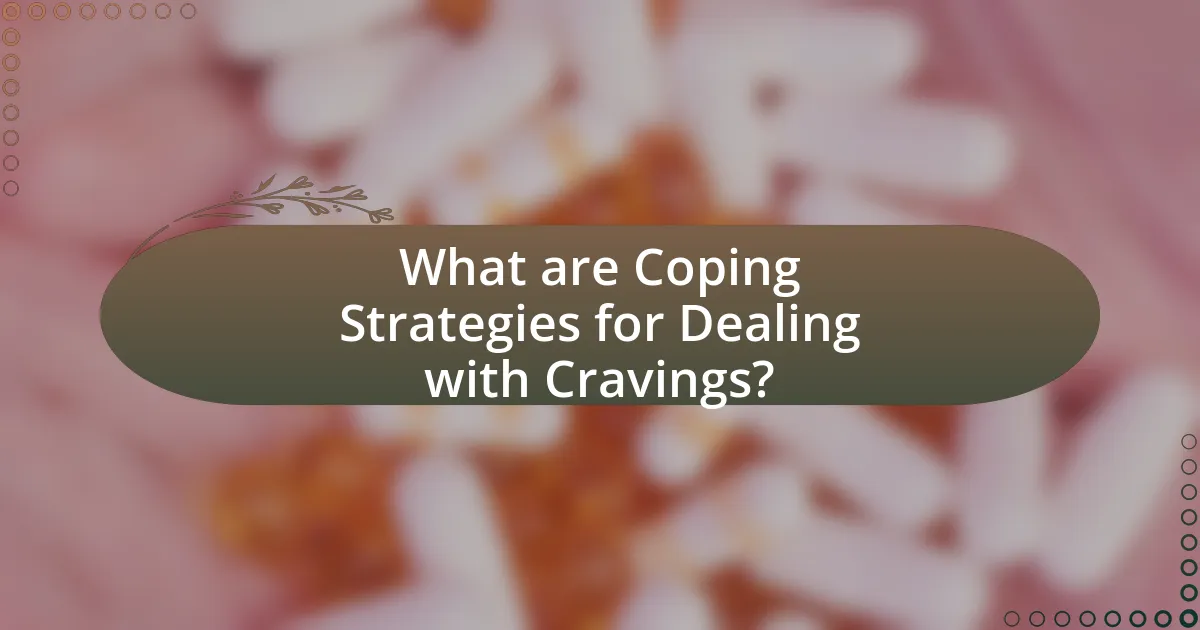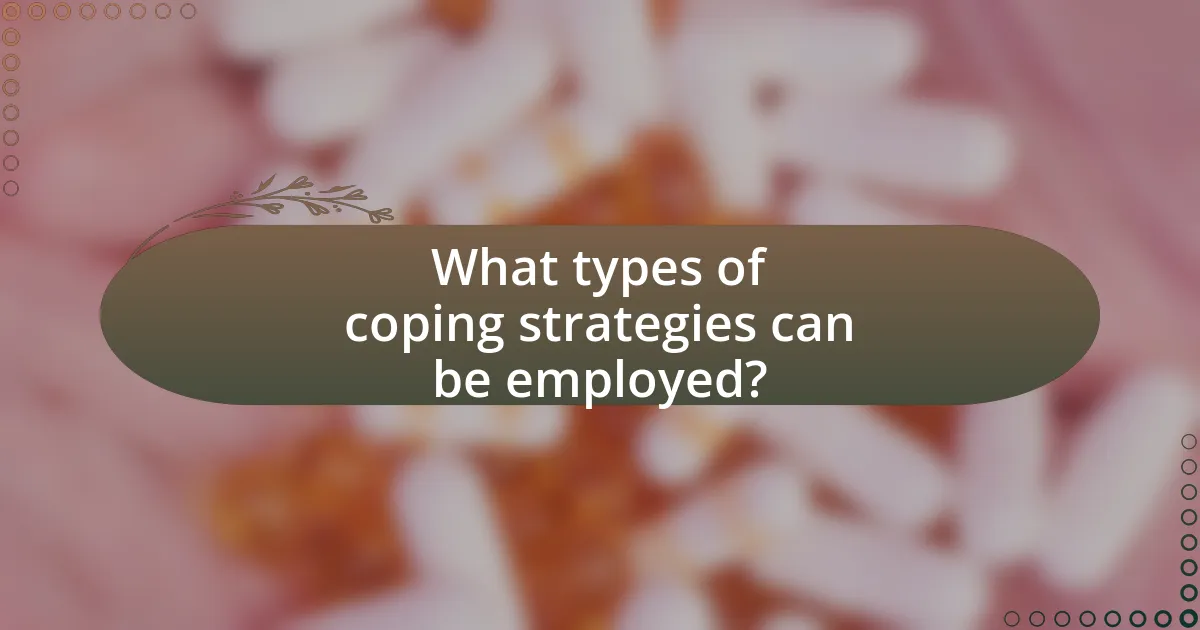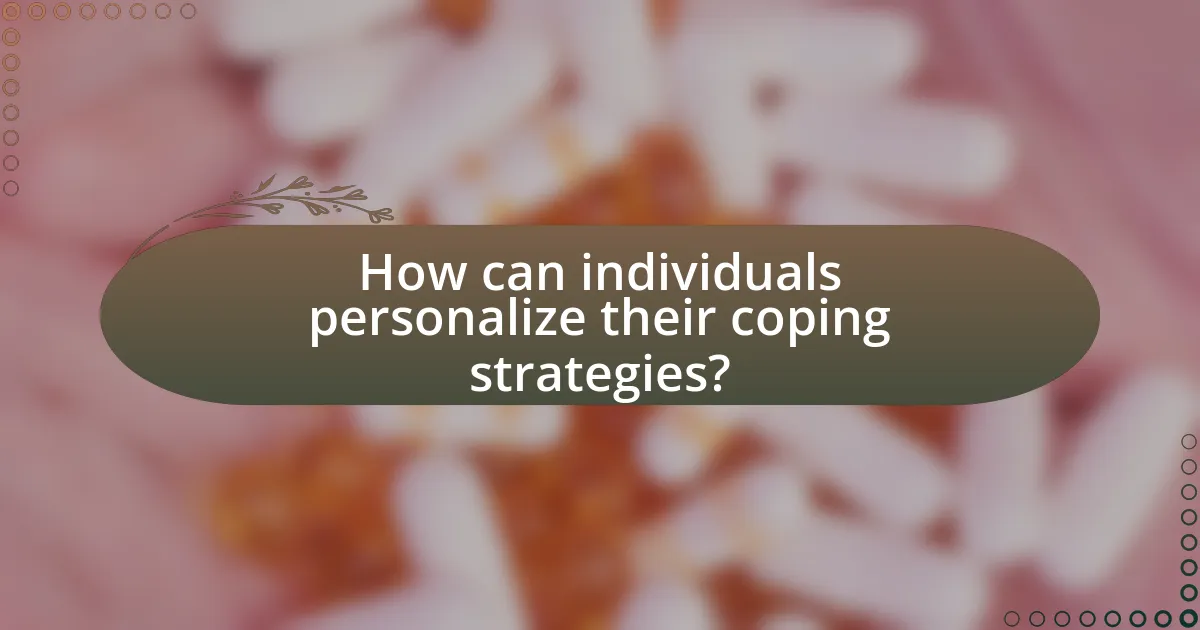Coping strategies for dealing with cravings are essential tools for managing urges related to food or substances. This article outlines various effective techniques, including distraction methods, mindfulness practices, and physical activity, which can help reduce the intensity of cravings and improve self-control. It also examines the emotional and physical impacts of cravings, common triggers, and the importance of personalized coping strategies. Additionally, the article highlights the role of social support and practical tips for implementing these strategies, emphasizing the significance of mindfulness and regular exercise in craving management. Understanding these elements can lead to better emotional resilience and overall well-being.

What are Coping Strategies for Dealing with Cravings?
Coping strategies for dealing with cravings include distraction techniques, mindfulness practices, and physical activity. Distraction techniques, such as engaging in hobbies or socializing, can redirect focus away from cravings. Mindfulness practices, including meditation and deep breathing, help individuals become aware of their cravings without acting on them. Physical activity, like walking or exercising, releases endorphins that can reduce the intensity of cravings. Research indicates that these strategies can effectively diminish cravings and improve self-control, as shown in studies published in journals like “Addictive Behaviors” and “Health Psychology.”
How do cravings affect individuals emotionally and physically?
Cravings significantly impact individuals both emotionally and physically. Emotionally, cravings can lead to feelings of anxiety, irritability, and frustration, as individuals often struggle with the desire for a specific substance or food that they may be trying to resist. Physically, cravings can manifest as increased heart rate, restlessness, and even withdrawal symptoms in cases of substance dependence, as the body reacts to the absence of the desired item. Research indicates that cravings activate the brain’s reward system, releasing dopamine, which reinforces the desire for the substance, thereby intensifying both emotional distress and physical sensations associated with the craving.
What are the common triggers for cravings?
Common triggers for cravings include emotional states, environmental cues, and physiological factors. Emotional states such as stress, anxiety, or sadness can lead individuals to seek comfort in food or substances. Environmental cues, like seeing advertisements or being in specific locations associated with past indulgences, can also provoke cravings. Physiological factors, including hunger or hormonal changes, play a significant role in triggering cravings as well. Research indicates that these triggers can significantly influence behavior, making it essential to recognize and manage them effectively.
How do cravings manifest in different contexts?
Cravings manifest in different contexts through various triggers such as emotional states, environmental cues, and social situations. For instance, individuals may experience cravings for specific foods when feeling stressed or anxious, as emotional distress often leads to comfort-seeking behaviors. Additionally, environmental cues like the sight or smell of food can evoke cravings, as demonstrated in studies showing that exposure to food-related stimuli increases the likelihood of craving that food. Social contexts, such as gatherings or celebrations, can also amplify cravings due to peer influence and the association of certain foods with positive experiences. These manifestations highlight the complex interplay between psychological, environmental, and social factors in the experience of cravings.
Why is it important to develop coping strategies for cravings?
Developing coping strategies for cravings is crucial because it helps individuals manage and reduce the intensity of their urges, thereby supporting healthier choices. Effective coping strategies can prevent relapse in behaviors such as substance use or unhealthy eating, which are often triggered by cravings. Research indicates that individuals who employ coping mechanisms, such as mindfulness or distraction techniques, report lower levels of craving and a higher likelihood of maintaining their goals. For instance, a study published in the journal “Addictive Behaviors” found that participants who utilized coping strategies experienced a significant decrease in cravings and improved self-control.
What are the potential consequences of unmanaged cravings?
Unmanaged cravings can lead to negative physical and psychological consequences. Physically, individuals may experience weight gain, as cravings often result in overeating or consuming unhealthy foods, which can contribute to obesity and related health issues such as diabetes and heart disease. Psychologically, unmanaged cravings can lead to increased stress, anxiety, and feelings of guilt or shame, which may exacerbate emotional eating patterns. Research indicates that individuals who struggle with cravings are more likely to develop eating disorders, as they may resort to binge eating or restrictive behaviors in an attempt to cope with their urges.
How can effective coping strategies improve overall well-being?
Effective coping strategies can significantly enhance overall well-being by providing individuals with tools to manage stress and emotional challenges. These strategies, such as mindfulness, problem-solving, and social support, enable individuals to navigate cravings and reduce the likelihood of relapse in addictive behaviors. Research indicates that individuals who employ effective coping mechanisms experience lower levels of anxiety and depression, leading to improved mental health outcomes. For instance, a study published in the Journal of Substance Abuse Treatment found that participants using cognitive-behavioral coping strategies reported a 30% reduction in cravings and a corresponding increase in life satisfaction. Thus, effective coping strategies not only address immediate cravings but also foster long-term emotional resilience and well-being.

What types of coping strategies can be employed?
Coping strategies for dealing with cravings include problem-focused coping, emotion-focused coping, and avoidance coping. Problem-focused coping involves actively addressing the source of cravings, such as engaging in alternative activities or seeking support from others. Emotion-focused coping aims to manage the emotional distress associated with cravings, often through techniques like mindfulness or relaxation exercises. Avoidance coping entails steering clear of triggers that may lead to cravings, such as avoiding certain environments or situations. Research indicates that employing a combination of these strategies can enhance effectiveness in managing cravings, as evidenced by studies showing improved outcomes in individuals utilizing diverse coping mechanisms.
How can mindfulness techniques help manage cravings?
Mindfulness techniques can help manage cravings by increasing awareness of the present moment and reducing impulsive reactions to those cravings. By practicing mindfulness, individuals learn to observe their cravings without judgment, allowing them to recognize the transient nature of these urges. Research indicates that mindfulness can decrease the intensity of cravings and improve self-control, as shown in a study published in the journal “Appetite,” where participants who engaged in mindfulness practices reported lower levels of craving for unhealthy foods compared to those who did not. This enhanced awareness and acceptance can lead to healthier decision-making and ultimately reduce the likelihood of succumbing to cravings.
What specific mindfulness practices are effective?
Effective mindfulness practices include meditation, body scanning, and mindful breathing. Meditation, particularly focused attention meditation, has been shown to reduce cravings by enhancing self-regulation and awareness of thoughts and feelings. Body scanning involves paying attention to physical sensations throughout the body, which can help individuals recognize and manage cravings as they arise. Mindful breathing, where individuals focus on their breath, promotes relaxation and can decrease the intensity of cravings. Research indicates that these practices can significantly lower the likelihood of relapse in individuals dealing with substance use disorders, as evidenced by studies published in journals such as “Mindfulness” and “Substance Use & Misuse.”
How does mindfulness change the perception of cravings?
Mindfulness alters the perception of cravings by promoting awareness and acceptance of the craving experience without immediate reaction. This practice allows individuals to observe cravings as temporary sensations rather than compelling demands, reducing their intensity and emotional charge. Research indicates that mindfulness can decrease the likelihood of succumbing to cravings, as evidenced by a study published in the journal “Appetite,” which found that participants who engaged in mindfulness meditation reported lower levels of craving and a greater ability to resist unhealthy food choices. By fostering a non-judgmental attitude towards cravings, mindfulness helps individuals detach from the urge to act on them, ultimately leading to healthier coping strategies.
What role does physical activity play in coping with cravings?
Physical activity plays a significant role in coping with cravings by reducing the intensity and frequency of these urges. Engaging in exercise releases endorphins, which can improve mood and decrease stress, factors that often exacerbate cravings. Research indicates that individuals who participate in regular physical activity report lower levels of cravings and a greater ability to manage them. For instance, a study published in the journal “Appetite” found that moderate exercise can effectively distract individuals from cravings and reduce their desire for unhealthy foods.
Which types of exercise are most beneficial for craving management?
Aerobic exercises, such as running, cycling, and swimming, are most beneficial for craving management. These activities increase endorphin levels, which can reduce cravings and improve mood. Research indicates that engaging in aerobic exercise for at least 30 minutes can significantly decrease the intensity of cravings, as shown in a study published in the journal “Psychology of Sport and Exercise” by authors like Raedeke and Smith. Additionally, strength training and yoga also contribute positively by promoting mindfulness and reducing stress, further aiding in craving management.
How does regular physical activity influence craving intensity?
Regular physical activity reduces craving intensity by altering neurobiological responses and improving mood. Engaging in exercise increases the release of endorphins and serotonin, which can diminish the desire for substances or behaviors that trigger cravings. Research indicates that individuals who participate in regular physical activity report lower levels of cravings and a greater ability to manage them. For example, a study published in the journal “Appetite” found that participants who engaged in consistent aerobic exercise experienced a significant reduction in food cravings compared to those who did not exercise. This evidence supports the conclusion that regular physical activity is an effective strategy for managing craving intensity.

How can individuals personalize their coping strategies?
Individuals can personalize their coping strategies by identifying their unique triggers and preferences, which allows them to select techniques that resonate with their individual experiences. For example, someone who finds comfort in physical activity may choose exercise as a coping mechanism, while another person might prefer mindfulness practices such as meditation or deep breathing. Research indicates that personalized coping strategies are more effective; a study published in the Journal of Consulting and Clinical Psychology found that tailored interventions significantly improved outcomes for individuals dealing with cravings. By assessing personal responses to stressors and experimenting with various coping methods, individuals can create a customized approach that enhances their ability to manage cravings effectively.
What factors should be considered when choosing coping strategies?
When choosing coping strategies for dealing with cravings, individuals should consider personal preferences, the nature of the craving, and the effectiveness of the strategy. Personal preferences influence the likelihood of adherence to a coping strategy; for example, someone who enjoys physical activity may find exercise more effective than meditation. The nature of the craving, whether it is emotional, situational, or physiological, also dictates which strategies may be most appropriate; for instance, mindfulness techniques may be beneficial for emotional cravings, while distraction techniques may work better for situational triggers. Lastly, the effectiveness of the strategy should be evaluated based on past experiences and evidence; research indicates that strategies like cognitive-behavioral techniques can significantly reduce cravings and improve coping outcomes.
How do personal preferences and lifestyle impact strategy selection?
Personal preferences and lifestyle significantly influence strategy selection by determining which coping mechanisms individuals find most appealing and feasible. For instance, someone who values physical activity may prefer exercise-based strategies to manage cravings, while another individual who enjoys social interactions might opt for support groups or social distractions. Research indicates that lifestyle factors, such as dietary habits and daily routines, shape the effectiveness of chosen strategies; for example, a study published in the Journal of Behavioral Medicine found that individuals with active lifestyles reported higher success rates in using physical activity as a coping strategy for cravings. Thus, aligning strategy selection with personal preferences and lifestyle enhances the likelihood of successful craving management.
What role does support from others play in developing coping strategies?
Support from others plays a crucial role in developing coping strategies by providing emotional, informational, and practical assistance. Emotional support from friends, family, or support groups can enhance an individual’s resilience, making it easier to manage cravings and stress. Research indicates that social support can lead to better mental health outcomes, as individuals who feel supported are more likely to engage in positive coping behaviors. For instance, a study published in the Journal of Substance Abuse Treatment found that individuals with strong social networks were more successful in maintaining abstinence from substance use, highlighting the importance of external support in coping strategy development.
What are some practical tips for implementing coping strategies?
Practical tips for implementing coping strategies include identifying triggers, developing a structured plan, and practicing mindfulness techniques. Identifying triggers involves recognizing specific situations or emotions that lead to cravings, which allows individuals to prepare for and manage these moments effectively. Developing a structured plan entails creating a step-by-step approach to cope with cravings, such as scheduling alternative activities or seeking support from friends or support groups. Practicing mindfulness techniques, such as deep breathing or meditation, can help individuals stay present and reduce the intensity of cravings. Research indicates that mindfulness can significantly decrease cravings and improve emotional regulation, making it a valuable tool in coping strategy implementation.
How can individuals track their cravings and responses effectively?
Individuals can track their cravings and responses effectively by maintaining a detailed journal that records the time, intensity, triggers, and emotional states associated with each craving. This method allows individuals to identify patterns and correlations between their cravings and specific situations or feelings. Research indicates that self-monitoring through journaling can enhance awareness and promote behavioral change, as evidenced by a study published in the Journal of Behavioral Medicine, which found that participants who tracked their cravings reported a 30% reduction in their urge to indulge. By consistently documenting their experiences, individuals can develop strategies to manage cravings more effectively.
What are some common pitfalls to avoid when managing cravings?
Common pitfalls to avoid when managing cravings include ignoring hunger cues, which can lead to overeating later, and relying solely on willpower, as studies show that willpower can be depleted over time. Additionally, avoiding triggers is crucial; exposure to environments or situations associated with cravings can increase the likelihood of succumbing to them. Another pitfall is neglecting to have healthy alternatives readily available, which can result in impulsive choices. Lastly, failing to practice mindfulness can hinder the ability to recognize and manage cravings effectively, as research indicates that mindfulness techniques can significantly reduce the intensity of cravings.
